Peru is an amazing country with mind-blowing landscapes, places full of history, delicious gastronomy and great people. That’s why we’re not surprised at all that you want to know more about the country or even visit it.
I mean who wouldn’t like to see Machu Picchu, one of the Seven Wonders of the World? Did you know that most recently they’ve discovered bones of the heaviest animal ever known? Yep, definitely Peru is a very interesting country.
So, if you want to truly know the country, the traditions, the people and the way they live, you’ll have to learn their language. Knowing Spanish will allow you to speak to Peruvians and hear what they have to say about their own country. You’ll be even more immersed in the culture.
But hey, it’s not enough to have taken a couple Spanish classes in high school. There are some things that most schools don’t teach and are part of any language and culture, like idioms. These are super important phrases rooted in every country’s population. And Peru is no exception.
Peruvians have their own expressions that they use daily. So, you need to learn at least these 15 Peruvian Spanish idioms so as not to get confused during a conversation. You might end up using some of them and impressing the natives.
15 Peruvian Idioms
1. Batería
This word means “drums”, yes, the musical instrument. But it’s also a word used to say “friend”. Other words you might hear when referring to a friend are “pata” and “causa”.
Memorize these words very well, because if you make a friend while visiting Peru, most likely they’ll call you like this.
2. ¡Qué palta!
“Palta” is avocado in some Hispanic countries, including Peru. But this expression is used when you’re embarrassed. It’s like saying “how embarrassing!”.
For example: Me caí frente a toda la escuela, ¡qué palta! (I fell in front of the whole school, how embarrassing!)
3. Al toque
It means “right now” or “immediately”.
For example: Tráeme mi teléfono al toque. (Bring me my phone immediately).
4. ¡Qué paja!
“Paja” is straw, chaff. But the expression ¡qué paja! Has nothing to do with that. It has two different meanings; it can be used to say something is cool or that you’re lazy.
For example: Mira su reloj, ¡qué paja! Ojalá fuera mío. (Look at her/his watch, how cool! Wish it was mine). Or: ¡Qué paja hacer la tarea! (How boring is to do the homework)
5. Estar misio
It’s used to say that you have no money. You might also hear it as “estar misionero” or as the famous movie franchise: “estar misión imposible”.
So if a friend asks you for money, you can tell them “estoy misio” to explain why you can’t lend them any.
6. ¡Qué piña! / Ser piña
“Piña” is pineapple in Spanish, but in these expressions it means bad luck. “Qué piña” is an expression for when you had bad luck or you’re unlucky. “Ser piña” has the same use, it’s for when you’re unlucky.
For example: Rayé mi coche. ¡Agh, qué piña! (I scratched my car. Agh, how unlucky!)
7. Meterse una bomba
It means you got or are going to get very drunk. You may also hear it as “meterse una bombaza”.
For example: George se metió una bomba tan tremenda en la fiesta de Lily que hizo el ridículo. (George got so drunk at Lily’s party that he embarrassed himself).
8. Ser pollo
It literally means “to be chicken”, but as an idiom a “pollo” is someone that gets drunk very easily.
9. ¿Cuál es tu cau cau?
In Peru “cau cau” is a typical dish, but it also means “problem”. So, when someone asks you “¿cuál es tu cau cau?”, they mean “what’s your problem?”.
10. Pan con mango
Literally it means “bread with mango”. Those two things seem like a weird mix, right? Well, that’s why Peruvians use this idiom when two completely different things are together and, therefore, it feels like a weird combination. Though it doesn’t have to be bad.
For example: Su relación es como pan con mango. Él es muy introvertido y prefiere estar en casa y ella es una completa extrovertida que ama salir. (Their relationship is a weird mix. He’s very introverted and prefers to be at home and she’s a complete extroverted that loves going out).
11. Hacer una chancha
This means to raise money for something. In Peruvian Spanish, “chancha” is a female pig. So, the idiom makes reference to the piggy banks, where one saves money.
For example: Vamos a hacer una chancha para pagar el viaje del equipo a los nacionales. (We’re going to raise money to pay for the team’s trip to nationals).
12. Ser lechero
In Spanish, “lechero” is the milkman. But as an idiom, it means someone that’s very lucky.
For example: Ian se ganó diez mil dólares, ¡qué lechero! (Ian won ten thousand dollars. Lucky man!)
13. Ser papaya
Yes, in Spanish “papaya” is also a fruit. But in Peru when something is papaya, it means it’s easy.
14. Estar a la tela
It means to be well and elegantly dressed. It makes sense, because “tela” is “fabric”.
For example: Es una boda, todos debemos de ir a la tela. (It’s a wedding, we all must go well dressed).
15. Dar bola
Used to say someone is paying attention to you, especially in a romantic way, like reciprocating the interest.
Put into Practice Your New Idioms with Fluency Corp
Congrats on your new Peruvian vocabulary! We know you’ve put a lot of effort into understanding the meaning behind these new idiomatic expressions. And we’re sure that effort will pay off, because now you’ll understand a conversation with natives more easily.
But there’s still more to do if you want to handle these idioms like a pro and master the Spanish language. You need to practice, so you can use them as well. Don’t worry, we’re to help.
TruFluency offers Spanish classes with native teachers! This makes it all the better, because you’ll learn correct pronunciation, accent and more everyday expressions, while training your listening with a native.
Some of the things we’re prouder of is our focus on speaking! With our Bellieu Method, made to speak using what you’ve learned, you’ll achieve language fluency. And yes, you’ll be able to use your new idioms during these speaking practices. That way, you’ll learn how and when to say them.
Signing up is not complicated at all. All our classes are online and we have very flexible schedules, because we know how busy your agenda is. Choose one of our language packages and schedule lessons to fit your schedule. Or take a two-hour trial class and get started on your language journey!





